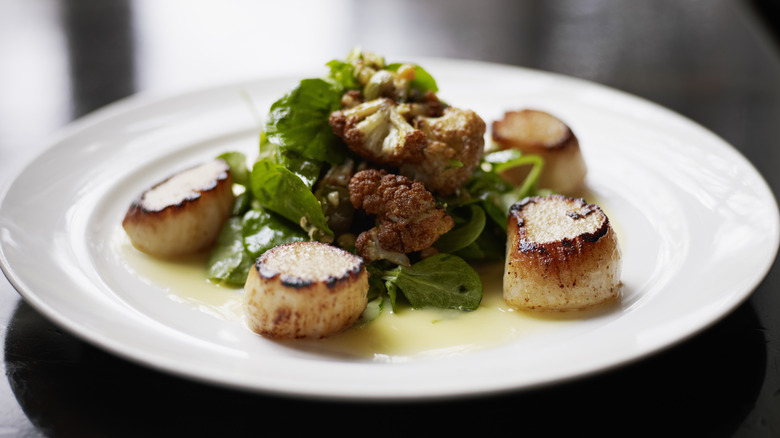Here's What It Takes To Become A Michelin Star Inspector
Becoming a Michelin star inspector typically means that you've got at least 10 years of industry-related experience under your belt. And of course, you need a discerning palate to honestly rate all kinds of restaurant food — even if you're not particularly a fan of an eatery's style of cuisine. Thankfully, Michelin Guide provides prospective inspectors (like you) with a five-point checklist to ensure that the ratings are consistent, no matter where the restaurants are located in the world. Product quality; cooking skills and techniques, plus a command of flavor; harmony amongst the myriad flavors; how the chef's personality shows itself in the food; and the consistency of the experience across multiple inspector visits all work together to determine a star rating. That is, if an establishment gets a star rating.
Michelin inspectors also have to be fans of travel — or if not fans, at least willing to do it, because the job requires a lot of time on the road. If you have your eye on this gig, this is how it breaks down. CNN reports that up to 75% of the inspector's time is earmarked for culinary adventures. Working weekends is also a requirement for this job, though admittedly, a delish one. Life isn't all weekend road trips to food cities, though. Once a year, Michelin editorial staff and inspectors hole up together to discuss which eateries are in the running for stars and why. Inspector notes, photos of food, and other supporting materials factor into the decision-making process.
The hiring and training process
Count on a grueling evaluation process in the event that your resume gets past the gatekeepers. If invited to interview, you, along with the other prospective candidates, must demonstrate your knowledge of food by submitting yourself to a written test. According to ex-Michelin Guide inspector Chris Watson, this little quiz lasts an hour and a half and might contain up to 200 questions (per Luxeat).
Since the inspectors' work ultimately becomes a part of the Michelin guidebook, a round of interviews with the deputy editor and other staff in that department follow for candidates who successfully pass the written portion of the process. The most successful aspirants are invited to lunch with the editor. This is no three-martini lunch. If you're in the hot seat, you're talking with the editor and rating the restaurant's food as you go.
The long interview process sets the stage for an even longer training period. Six months of shadowing experienced inspectors kicks off a newbie's career. It's one that's not always upwardly mobile in the way you might expect. Inspectors usually stay on the job for around five years, and many of them remain in that position from start to finish. According to ZipRecruiter, pay comes in at around $55,000. When the time comes to leave the gig, jobs in food writing or consulting count among the positions that open up for a former inspector. However, others have moved into jobs in Michelin's editorial department.
Other factors affecting a Michelin inspector's job
It also helps if you look like Joe Schmoe instead of the culinary equivalent of Sherlock Holmes, though you'll have about as many aliases as Holmes. But no matter what identity you come into the restaurant with, you've got to convince the waitstaff that you're pretty much nobody — just someone who likes really good food and not a Michelin inspector. In other words, the point of the secret identity is to get the restaurant staff to treat you like you're any other customer.
What Michelin doesn't want is for the staff of an eatery to give better service to the inspector than it would to its "normal" guests. Restaurant-goers care about Michelin star ratings because those rankings help them choose where to eat. In light of that, the quality of the food should be the same regardless of who's eating it. The Michelin inspectors are there to ensure that this is the case.
Michelin inspectors work odd hours, with literally every meal being on the table as a possible job site. Their schedules are erratic, to say the least. And the inspector's on-the-job experience isn't the glam-fest you might think it is. According to Luxeat, only one out of 10 restaurant meals earn a Michelin star rating. Or is even the proverbial honorable mention. Eating more than one dinner in a day is a thing, too, if the inspector has a lot of eateries to visit on the docket and too little time to visit them.
For the love of the plate
It probably goes without saying that would-be inspectors better love eating in restaurants more than they love anything else. According to CNN, about 275 of their meals per year start with them perusing a restaurant menu, sometimes sitting by their lonesome for potentially three meals a day. As far as restaurant service goes, that's nice and all, but really, the inspector's there to check out what's on the plate. This all of them — in the 39 regions the company covers — base their ratings on. The contents of the platter may change, depending on what goes in and out of style. Still, whatever the chef makes should look and taste superior.
In any event, one-star meals feature local produce and honor the authenticity of the cooking style. At two stars, meals become more complex. Ingredients might be unusual. The preparation or cooking techniques show off a masterful execution of skill. And three stars? The quality should be consistent from visit to visit.
Make no mistake about it. If your restaurant's in the running for three stars — Michelin's highest mark — the inspector (and possibly the inspector's co-workers) will visit again. Rebecca Burr, a former inspector and editor of the "Michelin Guide Great Britain and Ireland," told CNN that three to five visits for a restaurant in the running for three stars in't unheard of. Some restaurants may earn even more visits from an inspector, all in the name of star-rating research. And if you're one of those inspectors, then it's bags packed and fork poised, ready for another trip.



